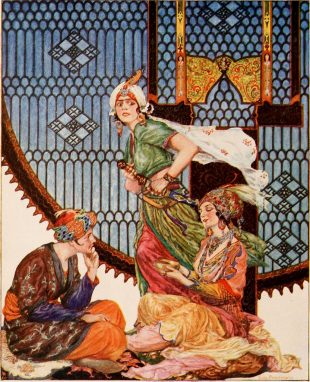Arabian Nights and Arabic Novels
 One Thousand and One Nights is often known in English as the Arabian Nights, from the first English-language edition (c. 1706 – c. 1721), which rendered the title as The Arabian Nights’ Entertainment, and where the most famous Arabic prose of tales was created.
One Thousand and One Nights is often known in English as the Arabian Nights, from the first English-language edition (c. 1706 – c. 1721), which rendered the title as The Arabian Nights’ Entertainment, and where the most famous Arabic prose of tales was created.
In some aspects, we could consider that these Arabian Nights tales are the grandmother of tales; not only in Arabic and Islamic countries but even in the western fantasy world of science fiction. This opinion thinks that the novel is not new to the Arabic literature, and it was present in Arab heritage, while a second opinion denies that there is a link between the novel and these old narrative forms. That certain connection mentioned by the first opinion school considers the similarities between the two types of writing and their contents, if old tales depend on retelling the history; the early novels did the same. History and attention to landmark events have been produced in Gergi Zidane (1861- 1914) historical novels. The early narrative pieces created in Arabic refer to “Leg on the Leg” by Ahmad Faris al-Shidyaq (1805 –1887). The Narrative of Isa Ibn Hisham or A Period of Time by Muhammad Muwaylihi which was first serialized and then published in book form in 1907 is often one of the texts referred to when it comes to the origins of the Arabic novel because of its narrative quality and (semi)realism when it comes to depicting society, although the demands of serialization gives it an episodic disjointedness. Zainab’s novel appeared in 1914, written by Dr. Muhammad Husayn Haykal (1888 – 1956), is considered the first serious attempt to develop an Arab novel according to the standards known to Westerners, while some other literary historians were to base the novel on the texts of Gibran Khalil Gibran (1883 – 1931), issued before Zainab: Broken Wings (1912), with its rebellious spirits, as a text developed at the global level, a text that achieves a distinguished presence and ranks with the best-selling international books in Europe and America. But the issue is neither a race nor a race but it is a product of the Egyptian central literary criticism, but Zeinab’s novel is still present in its naiveté, by its simplicity, by the impact of classical European writing. The most interesting thing is that its author published it unnamed, as he was shy to make his name appearing by just a story!
A Journey of Realistic Fiction
Until the 1930s, the novel turned to a realistic curve. This led to the clarification of the cultural vision of this generation. European culture has become a fundamental material of the synthesis of Arab thought. This culture was influenced by the European ways of organizing their new movements. This stage is accompanied by examples of novelist works such as Taha Hussein (1889 – 1973), Mahmoud Taymour (1871 – 1930) and Tawfiq al-Hakim (1898 –1987) . Naguib Mahfouz (December 11, 1911 – August 30, 2006), who won the Nobel Prize in Literature, 1988, has emerged the Arabic novel to another upgraded stage. The reality of Naguib Mahfouz has obscured the reality of a heavy and varied Egyptian and Arab production, and out from his coat, a new generation will appear trying to reveal a new face of the Arabic novel; with new novel sensibilities, which began from the early sixties to today, which will make the Arabic novel a profound transformation in its textual formations. After Naguib Mahfouz highlighted the Arab narrative production process, and was able to establish its artistic construction, a new phase began. In a certain historical period with distinct characteristics, the novel – as an emerging literary form – has been able to emerge and evolve through many experiences. We could consider Arab novelists to have their own projects expressed in a series of novels related to each other. Palestinian novelists like Ibrahim Nasrallah) 1954) will certainly focus on occupying his homeland by Israel. Hanna Mina, (1924), has been a great lover of his Syrian sea and people, and this love was reflected well in his novels. The Egyptian Gamal El-Ghitani (1945 –2015), who wrote historical fiction to express his love to the history and heritage. Young generations went from the Arab centers to the new ones; especially in the Arabin Gulf state. Saud Alsanousi, Kuwait (born 1981), whose novel “The Bamboo Stalk”; about immigrant workers in Kuwait, won the International Prize for Arabic Fiction. As millions of Egyptians have been working in the Arabian Gulf states, I was keen to monitor their lives in my novels, with a special novelistic project on the lives of these non-citizens. In my recent novel; Al-Turjoman, “The Translator” a Kuwaiti writer lost her husband during the Iraqi invasion of Kuwait, after 20 years of his absence she is suffering again because of a new lover. In 28 chapters narrated by 28 characters with many nationalities, the readers travel to different cities across the world and reflect the cosmopolitan atmosphere, which represents the mirror of the author’s migration, starting with Kuwait, where the translator lived, through Cairo, Alexandria, Manila, Damascus, Toronto, Mumbai and other destinations. To some extent, it reminds us with the separate, by yet connected, prologues of the Arabian nights. And it is not the only example, as many Arab novelists still reflect that sense of the first interesting epical prose.
By Ashraf Dali, Egyptian poet, novelist and journalist
























































